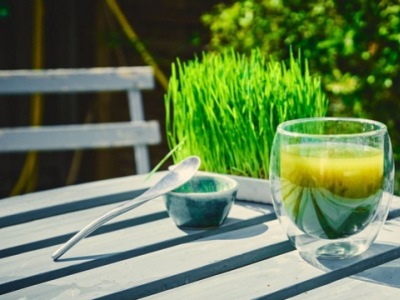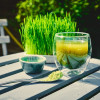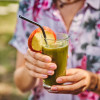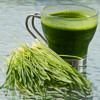Instructions
Germination of the seeds in general including barley seeds: Instructions for use. Choice of material. We use:
• either ready-to-use sprouters sold in the market (at 2 levels or more);
• or a white glass jar (old can or jam jar, for example). In addition, you will need:
• mosquito net fabric and an elastic band per bottle, which will serve as a cover through which air can enter;
• seeds of organic origin, relatively new and in good condition;
• preferably filtered drinking water or water of good biological quality.
As the cold slows down germination, you have to choose a sufficiently warm room in winter (such as the kitchen). Electric germinators can be found on the market to maintain an ideal constant temperature. For beginners, it is advisable to start with very small amounts: 1 to 2 tablespoons, for example.
The different stages of germination to be observed
• Pour the necessary amount of seeds into the jar and soak in water for about 12 hours (preferably use filtered or spring water). The seeds should be widely submerged in a good volume of water. If they are not very clean, they can be washed with plenty of water before soaking them. For small seeds (such as alfalfa, sesame, shelled sunflower), the soaking time can be reduced to between 1 to 5 hours.
• During the first soaking phase, the jar will be upright.
• After this soaking period, rinse the seeds thoroughly, 1 to 2 times a day, with cold filtered water in summer and lukewarm water in winter.
• For the second phase, the jar will be placed horizontally or slightly tilted obliquely at about 30° so that the seeds can “breathe” and not be piled on top of each other.
• Do not add too many seeds, in order to promote good oxygenation.
• The place chosen for your crops should be ventilated, but not too much exposure to sunlight.
• After a few days of germination, the seeds will be ready for consumption
• For wheat and cereals, the germ can be 1 to 3 mm in length.
• Small seeds (radish, cabbage, etc.) can be eaten until the sprout is 2 or 3 cm.
• For sunflower, alfalfa and soybean, the sprouts can be 6 to 7 cm. Never eat the soybean itself, only the sprout.
• Do not sprout nightshade seeds (such as potatoes, eggplants, tomatoes, peppers).
Consumption of sprouted seeds
The sprouted seeds are eaten:
• either alone (preferably 1 to 3 tablespoons in the morning or at noon);
• or in association with raw vegetables;
• or in association with oleaginous fruits (but not with watery fruits);
• or by incorporating them in a soup;
• or in combination with cereals (sprouted legumes and pasta or rice, for example);
• or with cereal pancakes;
• or in the form of powdered sprouted seeds incorporated into cookies; etc.
Seeds sprouted into shoots
While the sprouted seed is eaten in sprouts of about 0.5 cm for cereals, it is eaten in shoots of 1 to 5 cm for legumes and vegetables.
Instructions
• Soak the seeds in a jar of water for about 12 hours.
• Get a plastic box or tray (with a waterproof bottom if you are in an apartment) and place about 1 to 2 cm of untreated soil from a countryside or from your garden in it.
• Moisten the soil with good quality water, then lay the seeds loosely.
• Cover the box with another tray or dark plastic to protect the seeds from light and moisture.
• Make sure that the humidity level is constant, especially in summer, by using a water sprayer if necessary morning and evening.
• As soon as the root appears after a few days, remove the cover.
• Allow light to penetrate, but do not expose young shoots to bright sunlight.
• The ideal temperature is between 20 to 25 ° C.
• The shoots can be eaten after a period of 7 to 14 days, depending on the seed's variety and the ambient temperature conditions.
• Young shoots can be eaten in combination with raw vegetables, sprouted seeds or salads, etc.
Wheat or barley grass juice is a great way to revitalize yourself. High-level athlete, Karine Herry, who is also a doctor, was 5 times French champion of the 100 kms and has accumulated victories in the 50 kms distance. In other words, to achieve such performances, she needs, in addition to exceptional physical condition, particularly studied food intake. “My 8 years of running practice to reach the international level have provoked a procession of classic events linked to my regular practice of training and to long-distance competitions: ENT infections, episodic cold sores, slight sleep and memory disorders … The regular intake of barley grass juice, integrated in my diet, not only made all of these disorders disappear but turned out to be an essential supplement to health and even a performance asset: in 10 days only, there was a clear effect on the quality of sleep, and less physical and intellectual asthenia after one month." This testimony is taken from the magazine Belle-Santé.
Despite the great nutrient content of wheat and the very good results obtained by Ann Wigmore with wheatgrass juice in her Hippocrates Health Institute, some clarification is nevertheless necessary. Wheatgrass juice produces a very sweet flavored drink that is not suitable for everyone, both tastefully and biochemically. In the case of candidiasis, the yeast infection is fed by sweet foods, which include sweet wheatgrass. The slightly bitter taste of barley, especially when mixed with carrot juice, for example, works best for many people. Doctor Yoshihide Hagiwara, Japanese researcher, after long laboratory work, discovered that, among 200 different plants having analyzed, it is the juice of young barley grass, which provided the greatest quantities of active ingredients: vitamins, minerals, trace-elements, enzymes and powerful antioxidants. When growing, barley is gluten-free. Wheat and corn are the two grains that have been most modified by humans over the past 2 centuries and as such they are not suitable for everyone.
Instructions
• Get some jars or sprouters and start by sproutiting the seeds.
• Soak the seeds for about 12 hours, then rinse. Then sprout them in jars
• Get some untreated soil. Collect it preferably from a wooded location, from the 30 to 50 centimeters of dark soil just under the grass or under the leaves.
• Get some trays, about two to eight inches long and six to eight inches wide, from a garden center. In principle, they are used to collect water from tubs intended for plants. A dozen trays will be needed: 6 as trays and 6 as lids.
• It is recommended to get a shelf that will allow you to organize the trays in a methodical way. The set (trays and shelf) can be placed in the kitchen.
• Collect your sprouted seeds after 2 to 3 days, depending on the temperature, and as soon as the roots become visible.
• Cover one of the trays with a 2- to 4-centimeter layer of good soil.
• Spread the sprouted seeds there and distribute them without pressing them together or stacking them.
• Spray the seeds and soil with a little water, moderately to prevent mold.
• Cover the whole with another tray and place the set in a place where the room temperature is 20 to 25°C.
• Check the soil's moisture level every day. Water only if necessary, using a sprayer.
• In summer, after 2 to 3 days, if the temperature is cooler, remove the cover and expose the tray to light, but never to direct sunlight. It is the balance between light and shade that will produce a very green and fresh wheat or barley grass.
• It is important to water or moisten the soil and seeds 1 to 2 times a day with a small water sprayer, sold in the garden section of DIY stores (preferably use filtered water).
• After 7 to 8 days, when the shoots or grass have reached a size of 8 to 15 centimeters at the most, you can start harvesting. The cut should be leveled with the base, as most of the nutrients are concentrated there. It is advisable to rinse the grass with good quality water, in order to eliminate certain microorganisms that can cause diarrhea or intestinal "disorders". You can use a salad spinner to drain all the water. If you can't do so, you can keep the cut grass in plastic boxes in the fridge for up to 7 days. The juice should preferably be drunk as soon as it is extracted or within a maximum of half an hour afterwards. 1 kg of wheat or barley grass enables to obtain 300 grams of juice; a bunch of wheatgrass of about 1.5 centimeters in diameter gives about 3 centiliters of juice. It is recommended to consume 6 to 12 centiliters daily.
• Start first with small amounts of 3 to 6 centiliters of pure juice or mixed with other vegetable juices, for example carrot, to reach afterwards the dose of 3 to 6 centiliters up to 3 to 4 times a day, in order to regenerate or in case of serious health problem.
• The extraction is done with a special very fine grinder, hand or electric, sold in health food stores or by mail order. Some firms offer all these materials for sale by mail order.
• You can also simply chew wheat or barley grass, but you will get only little juice. Don't swallow the fibers, spit them out!
• At the Hippocrates Health Center in Florida, wheatgrass juice is also used as a rectal implant or as an enema. Enemas to cleanse the colon, followed by a wheatgrass implant, have great health benefits. In the form of an implant, which purifies the colon, fresh wheatgrass juice is inserted into the rectum where it should be kept for about 20 minutes before expelling it.
• Put 3 to 6 centiliters of fresh wheatgrass juice into a sterile enema bulb and insert it into the rectum. Then, after having evacuated them, a few minutes later, redo an implant of 3 to 6 centilitres of juice that you will allow to be eliminated naturally as soon as the need arises, most often after about twenty minutes. In many cases, the body will have absorbed all of the juice.
• At the Hippocrates Center, wheatgrass juice is also used in local applications on the skin to regenerate it or in case of itching, burning, scratching, irritation, stinging, etc.
°°°°°°°°°°°°°°°°°°°°°°°°°°°°°°
Eric Darche, Naturopath specialized in nutrition. Author, Speaker,
information about the author.
Eric Darche / Hygienist-naturopath, author of 9 books, lecturer.
Creator of an online hygienic and naturopathic school: ENHED
Facebook Group : Naturopathie, hygiéniste et alimentation vivante.
Consultations by appointment and advice also by phone. Phone: 09 50 24 05 34.
°°°°°°°°°°°°°°°°°°°°°°°°°°°°°°
DEMONSTRATION VIDEO FOR BARLEY SEED GERMINATION:
https://www.youtube.com/watch?
°°°°°°°°°°°°°°°°°°°°°°°°°°°°°°





